A Data-Driven Approach to Analyzing Fuel-Switching Behavior and Predictive Modeling of Liquefied Natural Gas and Low Sulfur Fuel Oil Consumption in Dual-Fuel Vessels
Abstract
1. Introduction
1.1. Background of Study
1.2. Aim of the Study
- Analyze and identify the energy usage patterns of LNG-fueled dual-fuel ships by employing data-driven methods that capture the unique operational profiles of each fuel mode under diverse voyage conditions. Establishing a comprehensive understanding of dual-fuel engine operational profiles is an essential first step, as these profiles provide insights necessary for optimizing fuel use and managing emissions in LNG-powered vessels. This analysis is invaluable in accurately identifying patterns and understanding the various factors—such as temperature, pressure, and regulatory requirements—that influence fuel switching, energy efficiency, and emissions outcomes.
- Machine learning models using LightGBM are developed to predict energy usage for each fuel type, specifically for the FO (LSFO) mode and GAS (LNG) mode. These models capture the variability in energy consumption under various voyage conditions. This approach aims to enhance prediction accuracy, allowing for more efficient energy management across modes and helping the maritime industry achieve its carbon reduction targets. The models developed in this study serve as critical tools to support energy-efficient operations and provide a structured approach for ensuring compliance with emissions regulations.
2. Literature Review
3. Data Description
3.1. Target Ship
3.2. Feature Selection
4. Methodologies
- Data Preprocessing: Missing values and outliers were removed, and medium- to high-speed segments, where fuel consumption is higher, were extracted.
- Mode Separation: Preprocessed data were separated by operation mode, distinguishing fuel oil (LSFO) sections from gas (LNG) sections.
- Fuel Consumption Pattern Analysis: Energy usage patterns and characteristics were analyzed for each voyage based on the separated modes.
- Data Split: The dataset was divided into training (80%) and testing (20%) sets to validate model performance.
- Prediction Modeling: LightGBM models were developed to predict fuel consumption for each mode.
- Prediction Results: Model accuracy was evaluated using RMSE, MAE, and R-squared (R2) on the test data.
4.1. Data Preprocessing
4.1.1. Data Filtering
4.1.2. Feature Transformation and Mode Separation
4.2. Operational Pattern Analysis
4.3. Fuel Consumption Prediction Model
5. Result and Discussion
5.1. Operational Pattern Analysis
5.1.1. Voyage 1: Speed-Induced Fuel Changeover Peaks
5.1.2. Voyage 2: Mixed Fuel Utilization and Directional Complexity
5.1.3. Voyage 3: Route Change Constraints on Fuel Switching
5.1.4. Voyage 4: Frequent Course Adjustments Leading to FO Spikes
5.1.5. Voyage 5: Speed and Directional Variability Triggering Fuel Peaks
5.1.6. Voyage 6: Complex Navigation with Frequent Fuel Shifts
5.1.7. Voyage 7: Stable Navigation with Controlled Fuel Switches
5.2. Prediction Model for Dual-Fuel Consumption
5.3. Discussion
- FO Mode Usage Strategy: The analysis revealed that during most voyages, fuel changeover peaks were observed when the ship experienced abrupt changes in speed. FO was predominantly used when the ship needed to accelerate or make sharp directional changes. This indicates a preference for FO in situations requiring immediate power output, as it provides quicker propulsion compared to GAS. This pattern was particularly evident in Voyages 1, 3, 4, 5, and 6. Notably, in Voyage 4, the FO mode was engaged not only during periods of speed increase but also during speed reductions, highlighting a unique pattern observed in this voyage. For instance, in Voyage 1, FO was used to handle speed variations and heading changes, while in Voyage 4 and 5, it was necessary for sharp course adjustments in narrow waterways. Additionally, FO was utilized in congested straits during Voyage 6 to navigate external challenges such as vessel traffic and unpredictable weather (Table 6). These findings suggest that FO offers better maneuverability and responsiveness under unstable route conditions.
- Gas Mode Usage Strategy: The GAS mode was primarily used in stable operating conditions where the ship could maintain consistent speed and direction. This reflects a strategy aimed at maximizing fuel efficiency, given that GAS is more economical, making it preferable during steady-state operations. This pattern was observed in Voyages 1, 3, 4, 5, and 7. For example, in Voyages 1 and 7, GAS was consistently maintained during prolonged cruising in open waters, ensuring reduced emissions and fuel costs. Similarly, in Voyage 5, GAS was predominantly used on relatively straight routes, while in Voyage 6, it was preferred for open stretches with low navigational demand (Table 6). These findings highlight the GAS mode’s suitability for stable and efficient operations.
- Flexibility of Mixed Fuel Mode: As observed in Voyage 2, the ship occasionally employed a mixed mode of FO and GAS to adapt to complex route conditions or external environmental changes. This strategy appears to aim at maintaining safe and efficient navigation by flexibly switching fuel modes to accommodate various operational conditions. For example, in Voyage 2, the mixed mode was used during narrow waterways and sharp course changes to balance FO’s power and GAS’s efficiency. Similarly, in Voyage 7, the mixed mode was employed in prolonged narrow passages, effectively combining the advantages of both fuels for intricate navigational scenarios (Table 6).
- In summary, the FO mode was ideal for dynamic and unstable conditions requiring immediate power, the GAS mode was suited for stable cruising, and the mixed mode provided versatility in complex operational situations. These findings underline the importance of tailored fuel-switching strategies to optimize both operational performance and environmental outcomes.
6. Conclusions
Author Contributions
Funding
Institutional Review Board Statement
Informed Consent Statement
Data Availability Statement
Conflicts of Interest
References
- Huang, M.T.; Zhai, P.M. Achieving Paris Agreement Temperature Goals Requires Carbon Neutrality by Middle Century with Far-Reaching Transitions in the Whole Society. Adv. Clim. Change Res. 2021, 12, 281–286. [Google Scholar] [CrossRef]
- Schreyer, F.; Luderer, G.; Rodrigues, R.; Pietzcker, R.C.; Baumstark, L.; Sugiyama, M.; Brecha, R.J.; Ueckerdt, F. Common but Differentiated Leadership: Strategies and Challenges for Carbon Neutrality by 2050 across Industrialized Economies. Environ. Res. Lett. 2020, 15, 114016. Available online: https://iopscience.iop.org/article/10.1088/1748-9326/abb852 (accessed on 16 October 2020). [CrossRef]
- Timofeev, G.; Podkolzin, P.; Gladilin, D. Global Trends and Challenges of Achieving Carbon Neutrality. Russ. J. Resour. Conserv. Recycl. 2022, 9, 1–14. [Google Scholar] [CrossRef]
- IMO. Second IMO Greenhouse Gas Study 2009; International Maritime Organization (IMO): London, UK, 2009; Available online: https://wwwcdn.imo.org/localresources/en/OurWork/Environment/Documents/SecondIMOGHGStudy2009.pdf (accessed on 1 April 2009).
- IMO. Fourth IMO Greenhouse Gas Study 2020: Executive Summary; International Maritime Organization (IMO): London, UK, 2020; Available online: https://wwwcdn.imo.org/localresources/en/OurWork/Environment/Documents/Fourth IMO GHG Study 2020 Executive-Summary.pdf (accessed on 4 August 2020).
- Maritime, I.; Traffic, T. International Maritime Trade and Port Traffic; United Nations: New York, NY, USA, 2021; pp. 1–33. [Google Scholar] [CrossRef]
- UNCTAD. Review of Maritime Transport 2020: International Maritime Trade and Port Traffic; United Nations Conference on Trade and Development (UNCTAD): New York, NY, USA, 2021; Available online: https://unctad.org/system/files/official-document/rmt2020_en.pdf (accessed on 1 October 2024).
- Rahim, M.M.; Islam, M.T.; Kuruppu, S. Regulating Global Shipping Corporations’ Accountability for Reducing Greenhouse Gas Emissions in the Seas. Mar. Policy 2016, 69, 159–170. [Google Scholar] [CrossRef]
- López-Aparicio, S.; Tønnesen, D.; Thanh, T.N.; Neilson, H. Shipping Emissions in a Nordic Port: Assessment of Mitigation Strategies. Transp. Res. Part D Transp. Environ. 2017, 53, 205–216. Available online: https://www.sciencedirect.com/science/article/abs/pii/S1361920915300481 (accessed on 26 April 2017). [CrossRef]
- Bortuzzo, V.; Bertagna, S.; Bucci, V. Mitigation of CO2 Emissions from Commercial Ships: Evaluation of the Technology Readiness Level of Carbon Capture Systems. Energies 2023, 16, 3646. [Google Scholar] [CrossRef]
- IMO. Resolution MEPC.304(72) (Adopted on 13 April 2018) Initial IMO Strategy on Reduction of GHG Emissions from Ships; International Maritime Organization (IMO): London, UK, 2018; Available online: https://wwwcdn.imo.org/localresources/en/KnowledgeCentre/IndexofIMOResolutions/MEPCDocuments/MEPC.304(72).pdf (accessed on 13 April 2018).
- IMO. Resolution MEPC.377(80), Annex 15, 2023 IMO Strategy on Reduction of GHG Emissions from Ships; International Maritime Organization (IMO): London, UK, 2023; Available online: https://wwwcdn.imo.org/localresources/en/KnowledgeCentre/IndexofIMOResolutions/MEPCDocuments/MEPC.377(80).pdf (accessed on 7 July 2023).
- IMO. IMO Train the Trainer (TTT) Course on Energy Efficient Ship Operation Module 2—Ship Energy Efficiency Regulations and Related Guidelines; International Maritime Organization (IMO): London, UK, 2016; Available online: https://wwwcdn.imo.org/localresources/en/OurWork/Environment/Documents/Air pollution/M2 EE regulations and guidelines final.pdf (accessed on 1 January 2016).
- IMO. 2013 Guidelines for Calculation of Reference Lines for Use with the Energy Efficiency Design Index (EEDI), Resolution MEPC.231(65); International Maritime Organization (IMO): London, UK, 2013; Available online: https://wwwcdn.imo.org/localresources/en/KnowledgeCentre/IndexofIMOResolutions/MEPCDocuments/MEPC.231(65).pdf (accessed on 17 May 2013).
- IMO. Amendments to the Annex of the Protocol of 1997 to Amend the International Convention for the Prevention of Pollution from Ships, 1973, as Modified by the Protocol of 1978 Relating Thereto (Revised MARPOL Annex VI), Resolution MEPC.328(76); International Maritime Organization (IMO): London, UK, 2021; Available online: https://wwwcdn.imo.org/localresources/en/KnowledgeCentre/IndexofIMOResolutions/MEPCDocuments/MEPC.328(76).pdf (accessed on 17 June 2021).
- ABS. Guide for Smart Functions for Marine Vessels and Offshore Units; American Bureau of Shipping (ABS): Texas, TX, USA, 2022; Available online: https://ww2.eagle.org/content/dam/eagle/rules-and-guides/current/other/307_smart_functions_marine_offshore_2022/smart-guide-jun22.pdf (accessed on 1 June 2022).
- Rachow, M.; Loest, S.; Sitinjak, L.R.M. Concept for a LNG Gas Handling System for a Dual Fuel Engine. Int. J. Mar. Eng. Innov. Res. 2017, 1, 272–283. [Google Scholar] [CrossRef]
- Livaniou, S.; Chatzistelios, G.; Lyridis, D.V.; Bellos, E. LNG vs. MDO in Marine Fuel Emissions Tracking. Sustainability 2022, 14, 3860. [Google Scholar] [CrossRef]
- Iannaccone, T.; Landucci, G.; Tugnoli, A.; Salzano, E.; Cozzani, V. Sustainability of Cruise Ship Fuel Systems: Comparison among LNG and Diesel Technologies. J. Clean. Prod. 2020, 260, 121069. [Google Scholar] [CrossRef]
- Xing, H.; Stuart, C.; Spence, S.; Chen, H. Alternative Fuel Options for Low Carbon Maritime Transportation: Pathways to 2050. J. Clean. Prod. 2021, 297, 126651. [Google Scholar] [CrossRef]
- Ng, C.K.L.; Liu, M.; Lam, J.S.L.; Yang, M. Accidental release of ammonia during ammonia bunkering: Dispersion behaviour under the influence of operational and weather conditions in Singapore. J. Hazard. Mater. 2023, 452, 131281. [Google Scholar] [CrossRef] [PubMed]
- McKinlay, C.J.; Turnock, S.R.; Hudson, D.A. Route to Zero Emission Shipping: Hydrogen, Ammonia or Methanol? Int. J. Hydrogen Energy 2021, 46, 28282–28297. [Google Scholar] [CrossRef]
- Kim, Y.R.; Jung, M.; Park, J.B. Development of a Fuel Consumption Prediction Model Based on Machine Learning Using Ship In-Service Data. J. Mar. Sci. Eng. 2021, 9, 137. [Google Scholar] [CrossRef]
- Hu, Z.; Jin, Y.; Hu, Q.; Sen, S.; Zhou, T.; Osman, M.T. Prediction of Fuel Consumption for Enroute Ship Based on Machine Learning. IEEE Access 2019, 7, 119497–119505. Available online: https://ieeexplore.ieee.org/document/8790676 (accessed on 1 October 2024). [CrossRef]
- Ahlgren, F.; Mondejar, M.E.; Thern, M. Predicting Dynamic Fuel Oil Consumption on Ships with Automated Machine Learning. Energy Procedia 2019, 158, 6126–6131. [Google Scholar] [CrossRef]
- Handayani, M.P.; Kim, H.; Lee, S.; Lee, J. Navigating Energy Efficiency: A Multifaceted Interpretability of Fuel Oil Consumption Prediction in Cargo Container Vessel Considering the Operational and Environmental Factors. J. Mar. Sci. Eng. 2023, 11, 2165. [Google Scholar] [CrossRef]
- Li, S.; Li, X.; Zuo, Y.; Li, T. Prediction of Ship Fuel Consumption Based on Elastic Network Regression Model. In Proceedings of the 2021 International Conference on Information, Cybernetics, and Computational Social Systems, ICCSS 2021, Beijing, China, 10–12 December 2021; Institute of Electrical and Electronics Engineers Inc.: New York, NY, USA, 2021; pp. 296–301. Available online: https://ieeexplore.ieee.org/stamp/stamp.jsp?tp=&arnumber=9721951 (accessed on 10 December 2021).
- Papandreou, C.; Ziakopoulos, A. Predicting VLCC Fuel Consumption with Machine Learning Using Operationally Available Sensor Data. Ocean. Eng. 2022, 243, 110321. [Google Scholar] [CrossRef]
- Sui, C.; de Vos, P.; Stapersma, D.; Visser, K.; Ding, Y. Fuel Consumption and Emissions of Ocean-Going Cargo Ship with Hybrid Propulsion and Different Fuels over Voyage. J. Mar. Sci. Eng. 2020, 8, 588. [Google Scholar] [CrossRef]
- Afon, Y.; Ervin, D. An Assessment of Air Emissions from Liquefied Natural Gas Ships Using Different Power Systems and Different Fuels. J. Air Waste Manag. Assoc. 2008, 58, 404–411. [Google Scholar] [CrossRef]
- Pokhrel, S. Resolution MEPC.391(81) (Adopted on 22 March 20 24) 2024 Guidelines on Life Cycle GHG Intensity of Marine Fuels; International Maritime Organization (IMO): London, UK, 2024; pp. 37–48. Available online: https://wwwcdn.imo.org/localresources/en/KnowledgeCentre/IndexofIMOResolutions/MEPCDocuments/MEPC.391(81).pdf (accessed on 22 March 2024).
- Bouabidi, Z.; Almomani, F.; Al-Musleh, E.I.; Katebah, M.A.; Hussein, M.M.; Shazed, A.R.; Karimi, I.A.; Alfadala, H. Study on Boil-off Gas (Bog) Minimization and Recovery Strategies from Actual Baseload Lng Export Terminal: Towards Sustainable Lng Chains. Energies 2021, 14, 3748. [Google Scholar] [CrossRef]
- Shih, Y.C.; Tzeng, Y.A.; Cheng, C.W.; Huang, C.H. Speed and Fuel Ratio Optimization for a Dual-Fuel Ship to Minimize Its Carbon Emissions and Cost. J. Mar. Sci. Eng. 2023, 11, 758. [Google Scholar] [CrossRef]
- Trodden, D.G.; Murphy, A.J.; Pazouki, K.; Sargeant, J. Fuel Usage Data Analysis for Efficient Shipping Operations. Ocean Eng. 2015, 110, 75–84. [Google Scholar] [CrossRef]
- Lee, J.; Eom, J.; Park, J.; Jo, J.; Kim, S. The Development of a Machine Learning-Based Carbon Emission Prediction Method for a Multi-Fuel-Propelled Smart Ship by Using Onboard Measurement Data. Sustainability. 2024, 16, 2381. [Google Scholar] [CrossRef]
- Li, S.; Zhang, P.; Sun, Z. Optimization of Fuel Supply Strategy for LNG Dual-Fuel Ships. J. Phys. Conf. Ser. 2022, 2491, 012014. Available online: https://iopscience.iop.org/article/10.1088/1742-6596/2491/1/012014/pdf (accessed on 16 December 2022). [CrossRef]
- Martinić-Cezar, S.; Bratić, K.; Jurić, Z.; Račić, N. Exhaust Emissions Reduction and Fuel Consumption from the LNG Energy System Depending on the Ship Operating Modes. Pomorstvo 2022, 36, 338–349. [Google Scholar] [CrossRef]
- Gelman, A. Exploratory Data Analysis for Complex Models. J. Comput. Graph. Stat. 2004, 13, 755–779. [Google Scholar] [CrossRef]
- Morgenthaler, S. Exploratory Data Analysis. Wiley Interdiscip. Rev. Comput. Stat. 2009, 1, 33–44. [Google Scholar] [CrossRef]
- Vorkapić, A.; Radonja, R.; Martinčić-Ipšić, S. Predicting Seagoing Ship Energy Efficiency from the Operational Data. Sensors 2021, 21, 2832. [Google Scholar] [CrossRef]
- Németh, M.; Borkin, D.; Michalconok, G. The Comparison of Machine-Learning Methods XGBoost and LightGBM to Predict Energy Development. AISC 2019, 1047, 208–215. Available online: https://link.springer.com/chapter/10.1007/978-3-030-31362-3_21 (accessed on 20 September 2019).
- Zhang, J.; Mucs, D.; Norinder, U.; Svensson, F. LightGBM: An Effective and Scalable Algorithm for Prediction of Chemical Toxicity-Application to the Tox21 and Mutagenicity Data Sets. J. Chem. Inf. Model. 2019, 44, 4150–4158. [Google Scholar] [CrossRef]
- Min, F.; Yaling, L.; Xi, Z.; Huan, C.; Yaqian, H.; Libo, F.; Qing, Y. Fault Prediction for Distribution Network Based on CNN and LightGBM Algorithm. In Proceedings of the 2019 14th IEEE International Conference on Electronic Measurement & Instruments (ICEMI), Changsha, China, 1–3 November 2019; pp. 1020–1026. Available online: https://ieeexplore.ieee.org/document/9101423 (accessed on 1 October 2024).
- Chen, X.; Zhang, H.; Bai, H.; Yang, C.; Zhao, X.; Li, B. Runtime Prediction of High-Performance Computing Jobs Based on Ensemble Learning. In Proceedings of the 2020 4th International Conference on High Performance Compilation, Computing and Communications, Association for Computing Machinery, Guangzhou, China, 27–29 June 2020; pp. 56–62. [Google Scholar] [CrossRef]
- Hartanto, A.D.; Kholik, Y.N.; Pristyanto, Y. Stock Price Time Series Data Forecasting Using the Light Gradient Boosting Machine (LightGBM) Model. Int. J. Inf. Vis. 2023, 7, 2270–2279. [Google Scholar] [CrossRef]
- Kumar, V.; Kedam, N.; Sharma, K.V.; Mehta, D.J.; Caloiero, T. Advanced Machine Learning Techniques to Improve Hydrological Prediction: A Comparative Analysis of Streamflow Prediction Models. Water 2023, 15, 2572. [Google Scholar] [CrossRef]
- Wang, Y.; Wang, T. Application of Improved LightGBM Model in Blood Glucose Prediction. Appl. Sci. 2020, 10, 3227. [Google Scholar] [CrossRef]
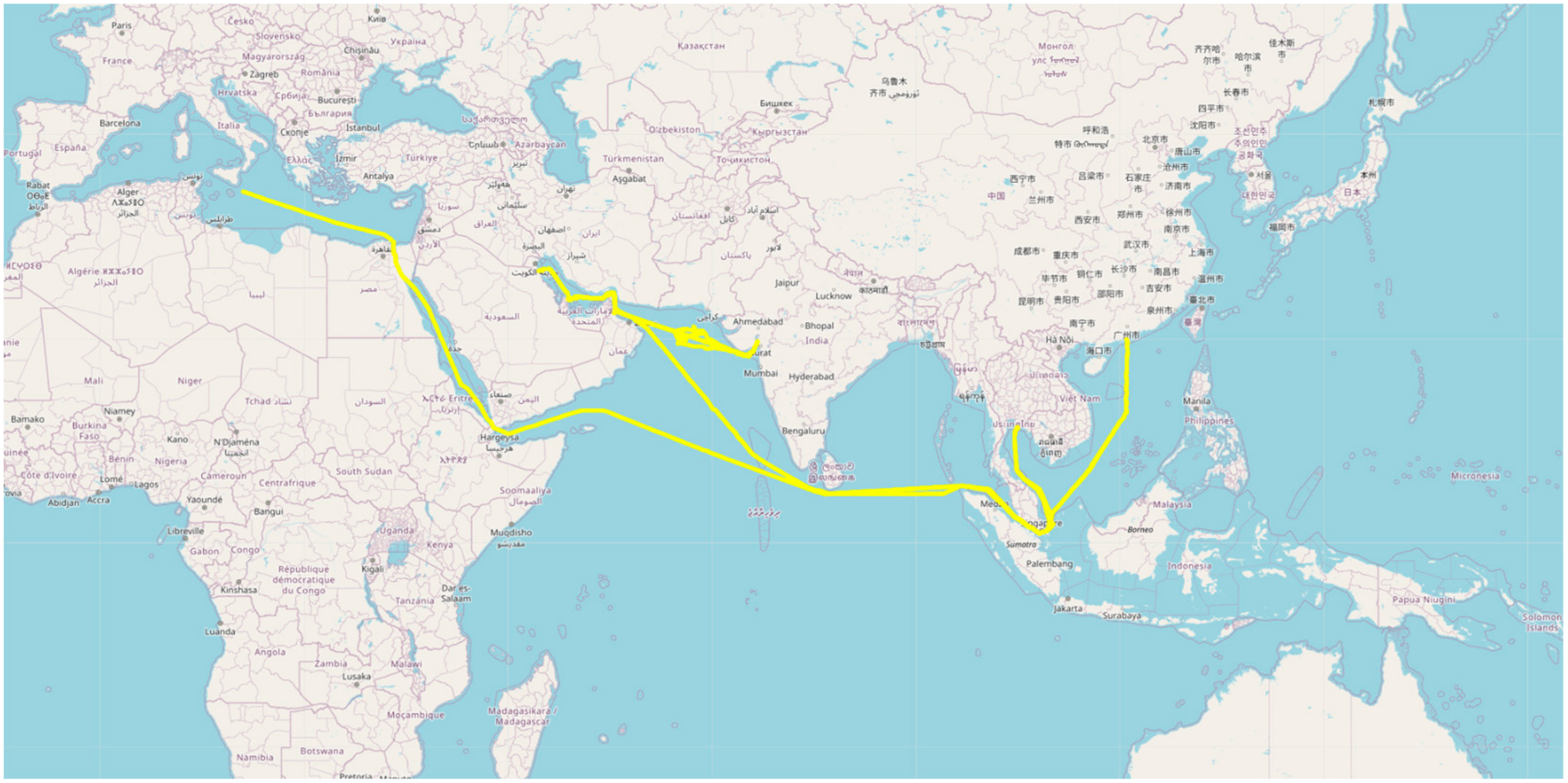
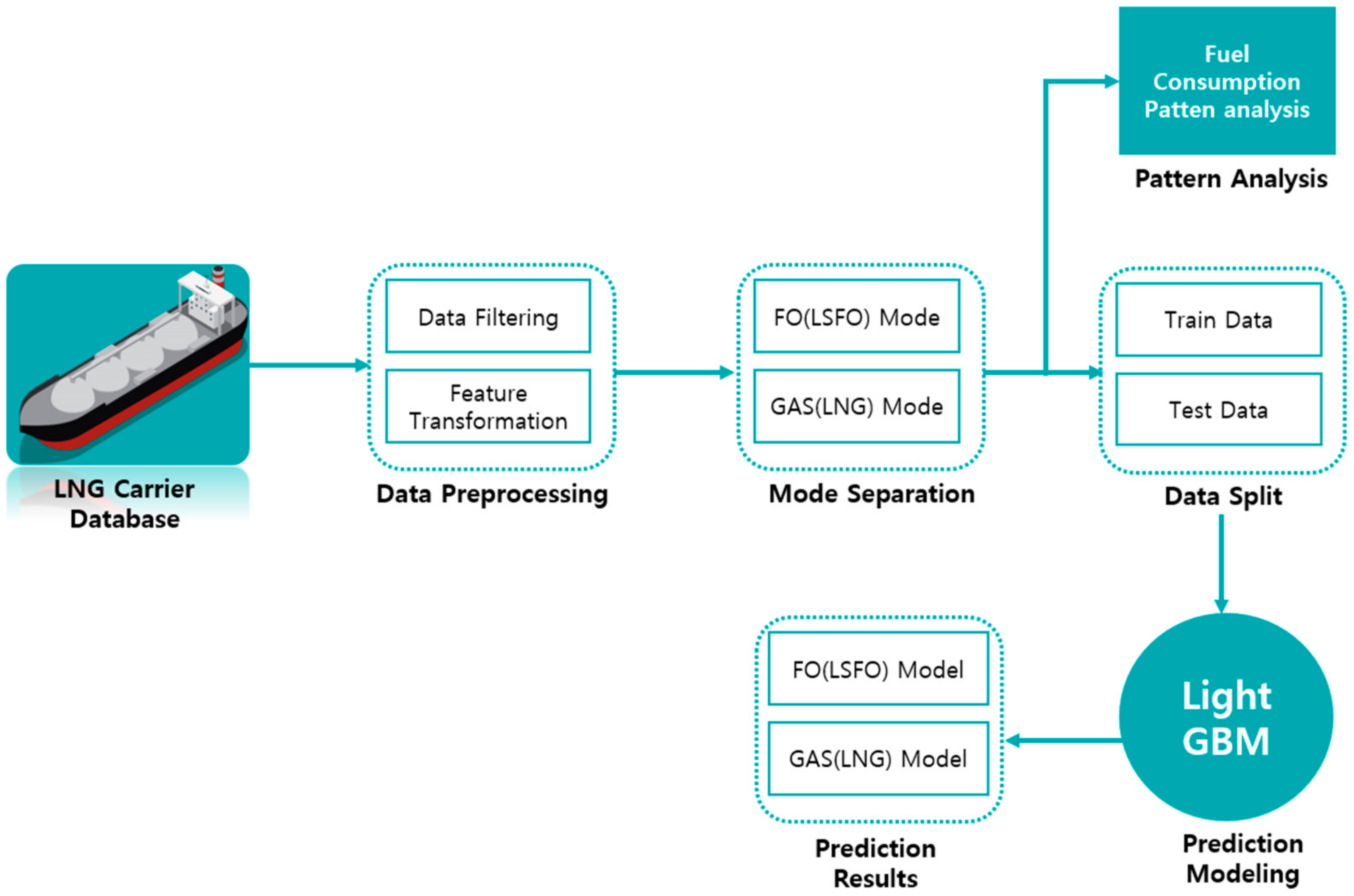


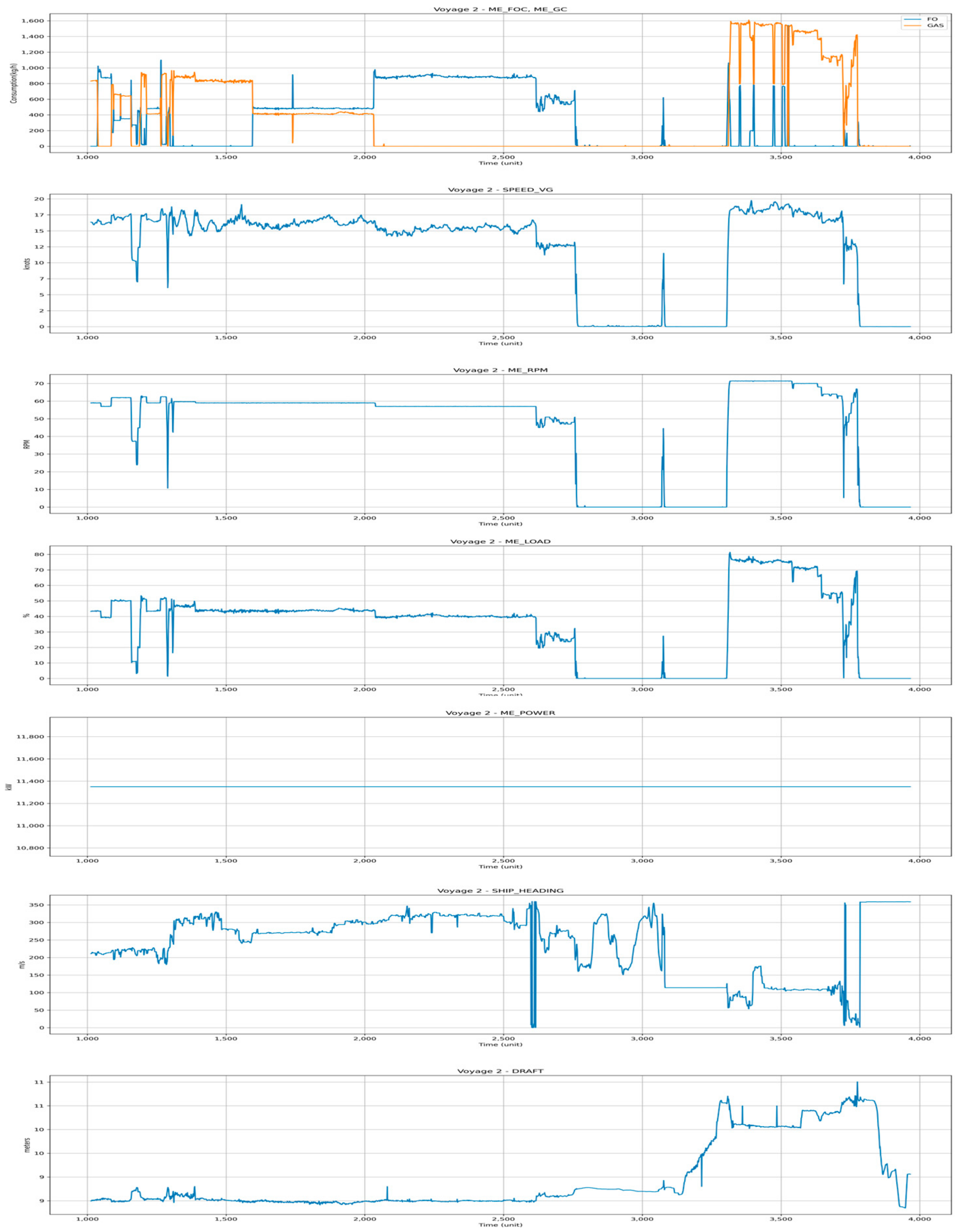


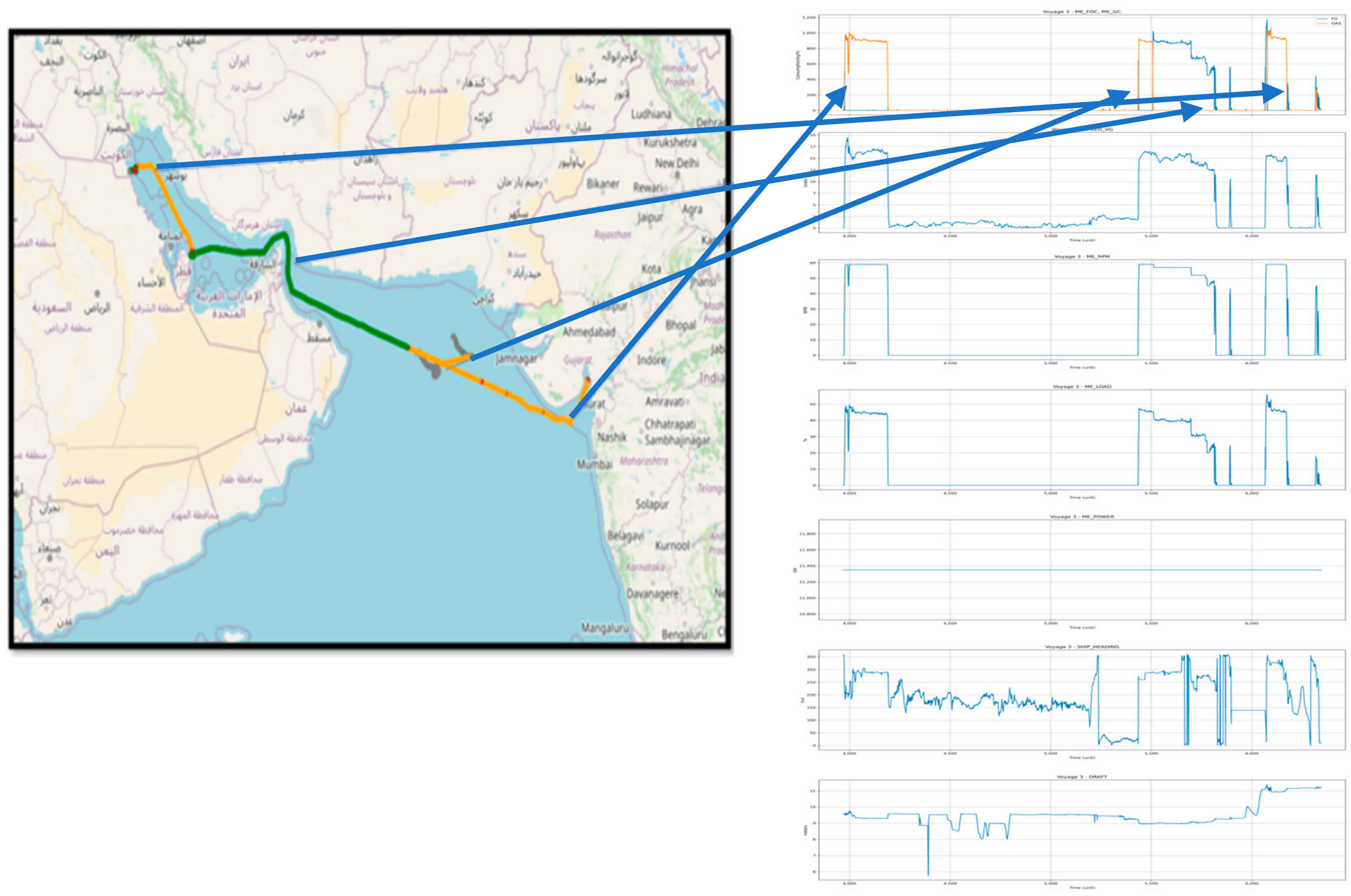
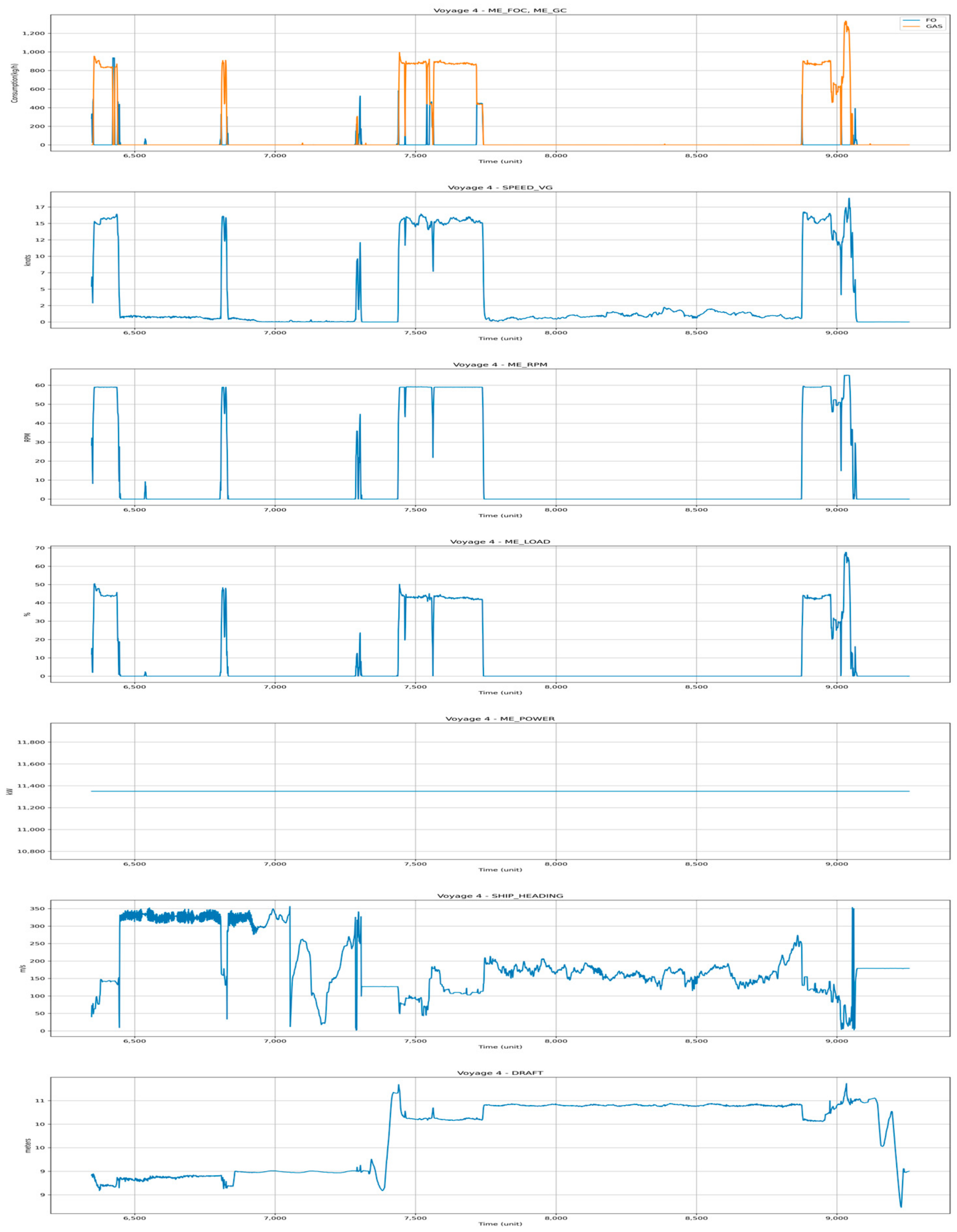



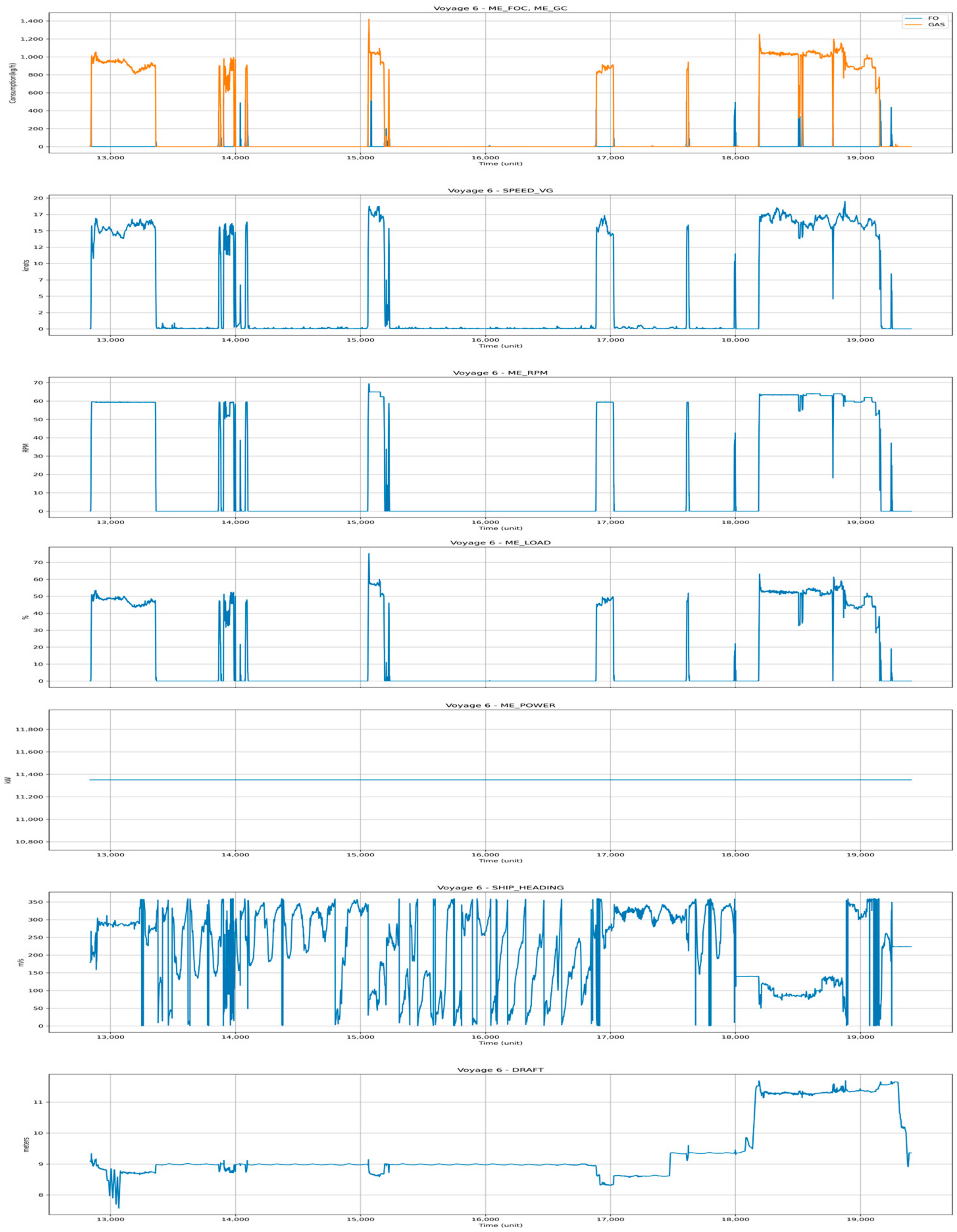
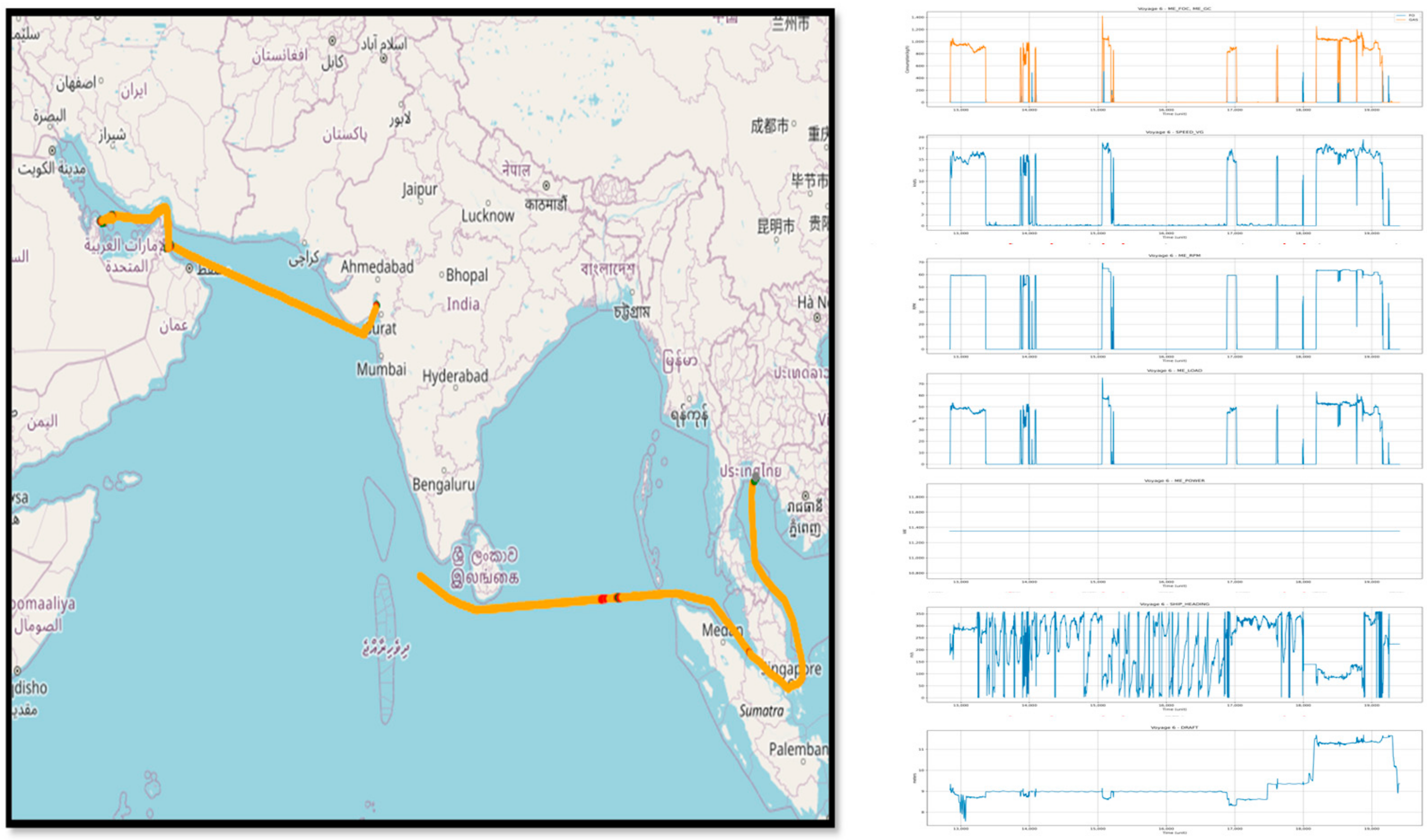
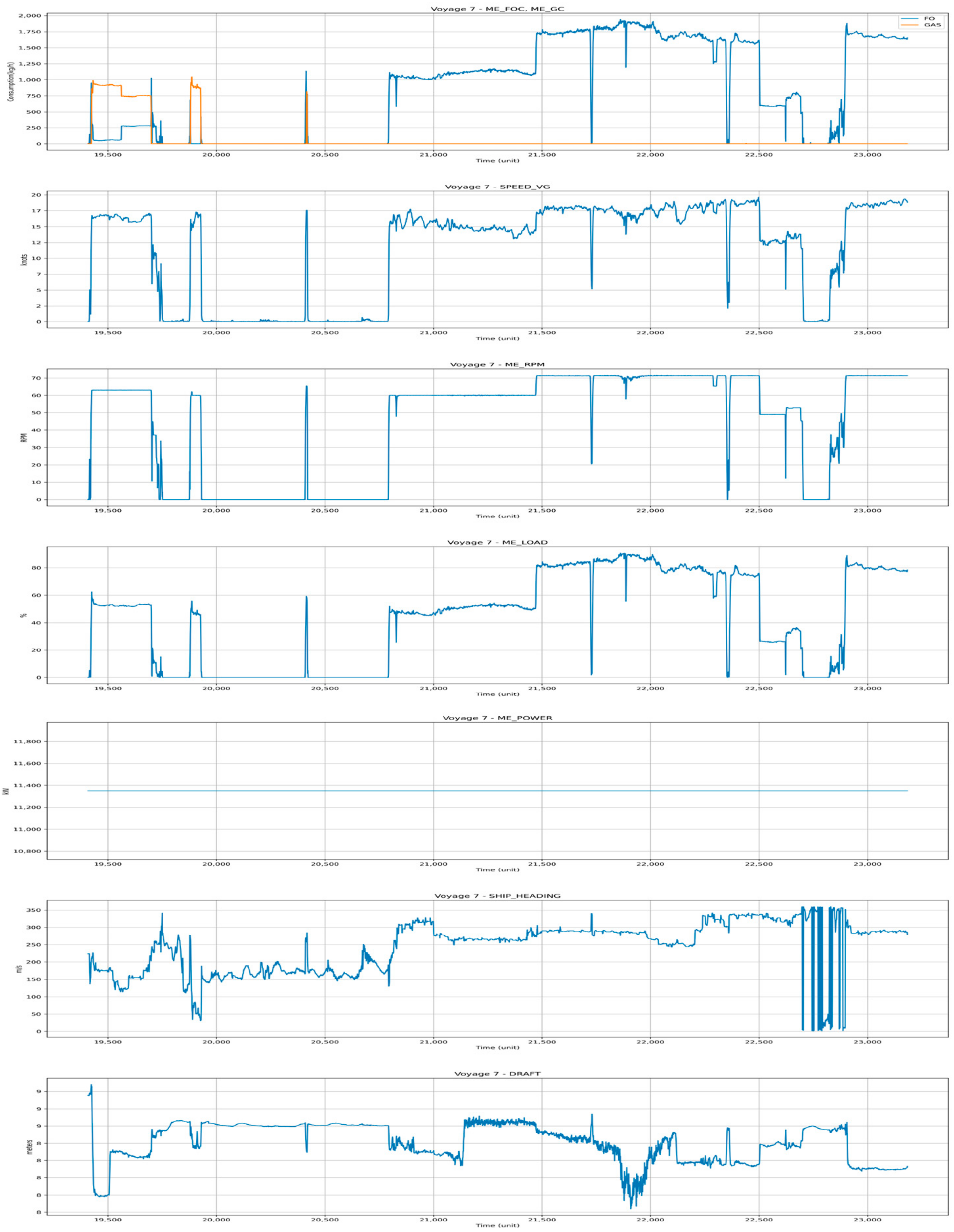
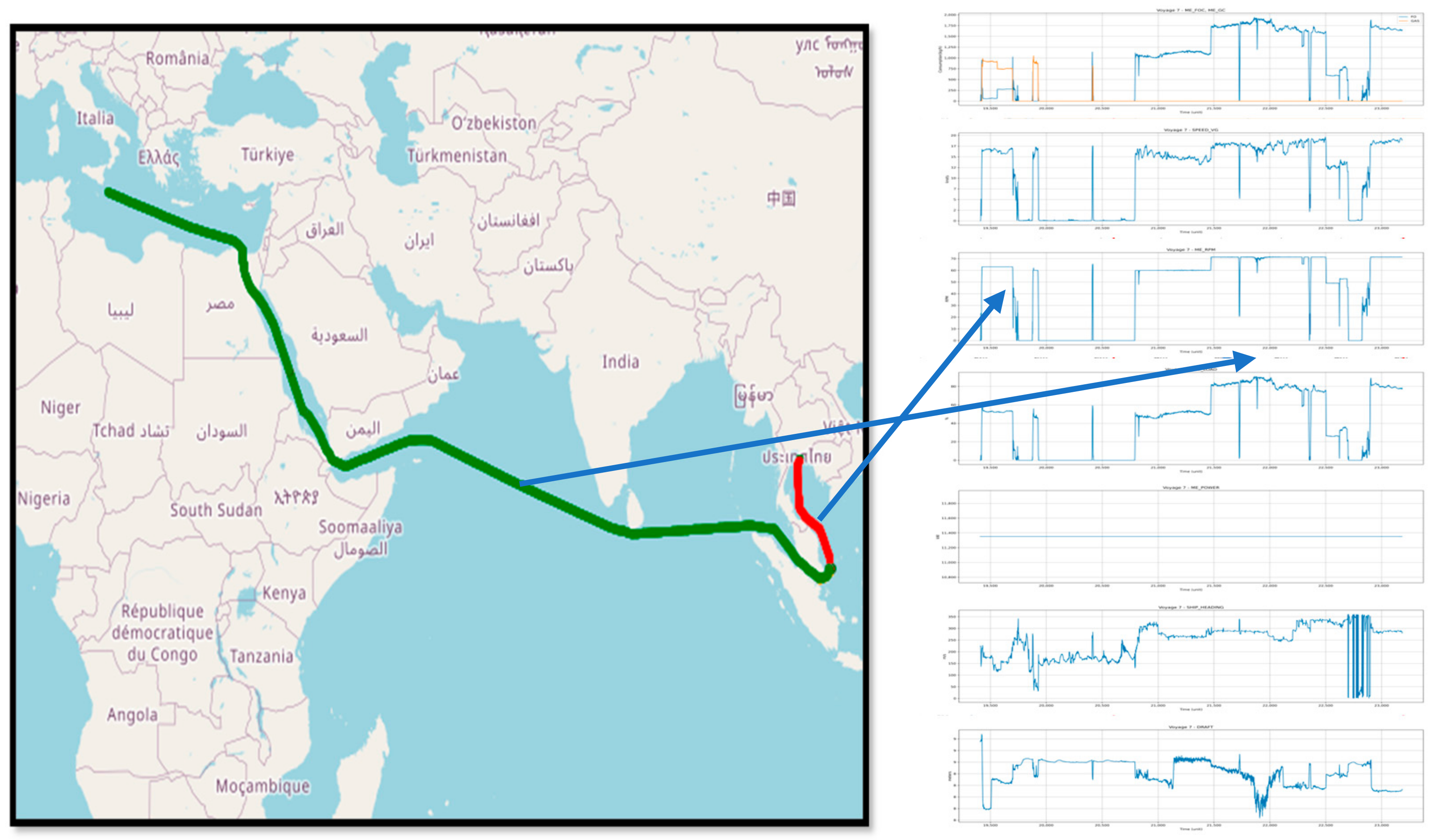
| Ship Particular | Dimension | Unit |
|---|---|---|
| Gross Tonnage | 114,000 | ton |
| Length Overall (LOA) | 293 | m |
| Breadth | 45 | m |
| Depth | 26 | m |
| Designed Draught | 11.5 | m |
| Type | Feature Name | Unit |
|---|---|---|
| Navigation | Speed over Ground (SOG) | knot |
| Ship Heading (HD) | degree | |
| Course over Ground (COG) | degree | |
| Rudder Angle (RUD) | degree | |
| Draught Fore | m | |
| Draught Aft | m | |
| Cargo | ton | |
| Engine | Main Engine 1,2 FO(LSFO) Consumption | kg/h |
| Main Engine 1,2 GAS(LNG) Consumption | kg/h | |
| Main Engine 1,2 RPM | revolution/min | |
| Main Engine 1,2 Load | % | |
| Main Engine 1,2 Power | kw | |
| Environmental | Relative Wind Speed | m/s |
| Relative Wind Direction | degree | |
| Current Speed | m/s | |
| Current Direction | degree | |
| Total Wave Height | m | |
| Total Wave Direction | degree | |
| Total Wave Period | - |
| Feature Name | Unit | Description |
|---|---|---|
| Main Engine Load | % | Average load of Main Engines 1 and 2 |
| Main Engine Power | kW | Average output of Main Engines 1 and 2 |
| Main Engine RPM | revolution/min | Average RPM of Main Engines 1 and 2 |
| Main Engine FOC | kg/h | Average LSFO consumption of Main Engines 1 and 2 |
| Main Engine GC | kg/h | Average LNG consumption of Main Engines 1 and 2 |
| Draft | m | Average draught of Draught Fore and Draught Aft |
| FO_MODE | - | LSFO mode (Main Engine FOC ≥ 1) |
| GAS_MODE | - | LNG mode (Maine Engine GC ≥ 1) |
| Hyperparameter | Range | Best Value |
|---|---|---|
| lambda_l1 | {0.0000001~10.0} | 0.000305 |
| lambda_l2 | {0.0000001~10.0} | 0.05957 |
| num_leaves | {2~256} | 207 |
| feature_fraction | {0.4~1.0} | 0.554 |
| bagging_fraction | {1~7} | 2 |
| min_child_samples | {5~100} | 5 |
| R2 Score | RMSE | MAE | ||||
|---|---|---|---|---|---|---|
| Mode | GAS | FO | GAS | FO | GAS | FO |
| Test | 0.94 | 0.98 | 33.01 | 48.36 | 16.29 | 22.92 |
| Voy | Profile Characteristics | Fuel Mode | Scenario |
|---|---|---|---|
| 1 | Open waters with speed variations | FO | FO was used to handle speed increases and decreases effectively, ensuring quick responsiveness during transitions. |
| Directional adjustments at key points | FO | Necessary to provide sufficient power during heading changes, ensuring stable maneuverability. | |
| Stable cruising | GAS | GAS was used for sustained cruising with minimal fluctuations, reducing emissions and fuel costs. | |
| 2 | Complex route with frequent adjustments | Mixed | Mixed mode was used for narrow waterways and sharp course changes, balancing FO’s power and GAS’s efficiency. |
| Stable cruising segments | GAS | Preferred for long, straight sections where minimal adjustments are required. | |
| Sharp directional changes | FO | Required for maintaining stability and responsiveness during abrupt course adjustments. | |
| 3 | Frequent course changes | FO | Used to handle unstable conditions with frequent adjustments in heading and speed. |
| Speed variations in open waters | FO | Critical for acceleration and deceleration phases in variable-speed regions. | |
| Prolonged steady-state operations | GAS | Utilized in stable, open-water sections with consistent speeds to maximize efficiency. | |
| 4 | Narrow waterways, frequent course adjustments | FO | Required during rapid speed changes and sharp course adjustments to maintain maneuverability. |
| Calm, straight sections | GAS | Used during steady cruising for optimal fuel efficiency. | |
| 5 | Tight navigational paths | FO | Critical for overcoming environmental resistance and navigating through complex, winding paths. |
| Open water between narrow sections | GAS | Enables sustained cruising at consistent speeds between confined navigational areas. | |
| 6 | Congested or busy straits | FO | Necessary to handle external challenges, including nearby vessel traffic and unpredictable weather. |
| Clear straits or open stretches | GAS | Preferred for low-demand routes with reduced complexity. | |
| 7 | Prolonged narrow passages | Mixed | Combines FO’s high-power availability with GAS’s cost efficiency for intricate navigational situations. |
| Minimal adjustment regions | GAS | Focused on maintaining emissions compliance and minimizing operational costs during stable navigation. |
Disclaimer/Publisher’s Note: The statements, opinions and data contained in all publications are solely those of the individual author(s) and contributor(s) and not of MDPI and/or the editor(s). MDPI and/or the editor(s) disclaim responsibility for any injury to people or property resulting from any ideas, methods, instructions or products referred to in the content. |
© 2024 by the authors. Licensee MDPI, Basel, Switzerland. This article is an open access article distributed under the terms and conditions of the Creative Commons Attribution (CC BY) license (https://creativecommons.org/licenses/by/4.0/).
Share and Cite
Kim, H.; Lee, S.; Lee, J.; Kim, D. A Data-Driven Approach to Analyzing Fuel-Switching Behavior and Predictive Modeling of Liquefied Natural Gas and Low Sulfur Fuel Oil Consumption in Dual-Fuel Vessels. J. Mar. Sci. Eng. 2024, 12, 2235. https://doi.org/10.3390/jmse12122235
Kim H, Lee S, Lee J, Kim D. A Data-Driven Approach to Analyzing Fuel-Switching Behavior and Predictive Modeling of Liquefied Natural Gas and Low Sulfur Fuel Oil Consumption in Dual-Fuel Vessels. Journal of Marine Science and Engineering. 2024; 12(12):2235. https://doi.org/10.3390/jmse12122235
Chicago/Turabian StyleKim, Hyunju, Sangbong Lee, Jihwan Lee, and Donghyun Kim. 2024. "A Data-Driven Approach to Analyzing Fuel-Switching Behavior and Predictive Modeling of Liquefied Natural Gas and Low Sulfur Fuel Oil Consumption in Dual-Fuel Vessels" Journal of Marine Science and Engineering 12, no. 12: 2235. https://doi.org/10.3390/jmse12122235
APA StyleKim, H., Lee, S., Lee, J., & Kim, D. (2024). A Data-Driven Approach to Analyzing Fuel-Switching Behavior and Predictive Modeling of Liquefied Natural Gas and Low Sulfur Fuel Oil Consumption in Dual-Fuel Vessels. Journal of Marine Science and Engineering, 12(12), 2235. https://doi.org/10.3390/jmse12122235






